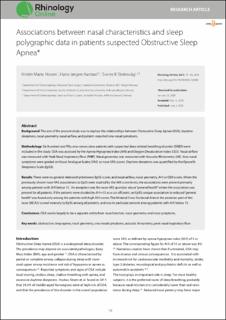| dc.contributor.author | Hoven, Kristin Marie | |
| dc.contributor.author | Aarstad, Hans Jørgen | |
| dc.contributor.author | Steinsvåg, Sverre Karmhus | |
| dc.date.accessioned | 2021-08-09T08:29:01Z | |
| dc.date.available | 2021-08-09T08:29:01Z | |
| dc.date.created | 2021-03-24T07:10:04Z | |
| dc.date.issued | 2020 | |
| dc.identifier.issn | 2589-5613 | |
| dc.identifier.uri | https://hdl.handle.net/11250/2766896 | |
| dc.description.abstract | Background: The aim of the present study was to explore the relationships between Obstructive Sleep Apnea (OSA), daytime sleepiness, nasal geometry, nasal airflow, and patient- reported sino-nasal symptoms.
Methodology: Six hundred and fifty-one consecutive patients with suspected sleep related breathing disorder (SRBD) were included in the study. OSA was assessed by the Apnea-Hypopnea Index (AHI) and Oxygen Desaturation Index (ODI). Nasal airflow was measured with Peak Nasal Inspiratory Flow (PNIF). Nasal geometry was measured with Acoustic Rhinometry (AR). Sino-nasal symptoms were graded on Visual Analogue Scales (VAS) as nose-VAS scores. Daytime sleepiness was quantified by the Epworth Sleepiness Scale (EpSS).
Results: There were no general relationship between EpSS scores and nasal airflow, nasal geometry, AHI or ODI scores. When the previously shown nose-VAS associations to EpSS were studied by the AHI score levels, the associations were present primarily among patients with AHI below 15. An exception was the nose-VAS question about “general health” where the association was present for all patients. If the patients were divided by AHI=15 as a cut-off point, an EpSS-unique association to reduced “general health” was found only among the patients with high AHI scores. The Minimal Cross Sectional Area in the posterior part of the nose (MCA2) scored inversely to EpSS among all patients, and was in particular present among patients with AHI below 15.
Conclusions: OSA seems largely to be a separate entity from nose function, nasal geometry and nose symptoms. | en_US |
| dc.language.iso | eng | en_US |
| dc.publisher | European Rhinologic Society | en_US |
| dc.rights | Navngivelse 4.0 Internasjonal | * |
| dc.rights.uri | http://creativecommons.org/licenses/by/4.0/deed.no | * |
| dc.title | Associations between nasal characteristics and sleep polygraphic data in patients suspected Obstructive Sleep Apnea | en_US |
| dc.type | Journal article | en_US |
| dc.type | Peer reviewed | en_US |
| dc.description.version | publishedVersion | en_US |
| dc.rights.holder | Copyright 2020 The Authors | en_US |
| cristin.ispublished | true | |
| cristin.fulltext | original | |
| cristin.qualitycode | 1 | |
| dc.identifier.doi | http://doi.org/10.4193/RHINOL/20.005 | |
| dc.identifier.cristin | 1900451 | |
| dc.source.journal | Rhinology Online | en_US |
| dc.source.pagenumber | 79-86 | en_US |
| dc.identifier.citation | Rhinology Online. 2020, 3, 79-86. | en_US |
| dc.source.volume | 3 | en_US |

